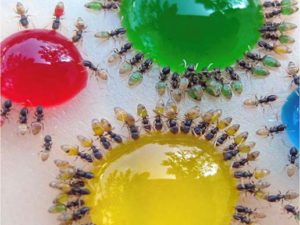Ants typically eat nectar, seeds, fungus, or insects. In this experiment you will be feeding the ants sugar. This amazing experiment can show your children how ants eat and drink, which teaches them about nature and the insects around them. Plus, it is such a fun thing to do, and a calming activity, as many nature activities seem to be. This experiment can ask two questions:
- Can ants turn the colour of the drink they drink?
- Is there a colour they prefer over another?
This is a great activity to do outside. Just make sure that you choose a white surface (a paper plate is fine) so your children can clearly see what happens. Learn more about ants before you try this experiment.
Best Ages for This Activity
This activity is great for two to five-year-old children (or older).
What You Will Need
- Food colouring
- Water
- Sugar
- Ants
- Cups
Optional Supplies
- A magnifying glass
- Pipettes (eye droppers)
Let’s Get Started
- In a cup, mix 5 ¼ cup of sugar with ½ cup water
- Pour a teaspoon of the mixture into a cup and add food colouring (make it very bright)
- For every colour you want to try, use a different cup and follow the same procedures. I would suggest 4 colours
- Bring a white paper plate outside and place it upside-down (so it is easier for the ants to climb) near an anthill or wherever you see that there are ants
- Using the pipette, carefully put a large drop of each colour on the plate, separated (see example in photo below)
- If you wish, add a large drop of milk as well, without food colouring or with – your preference

You are now ready! Stand close to the plate with your magnifying glass and wait for the ants to find your experiment. Remember to watch that other animals or your pets don’t lick your experiment off the plate. You can stay and observe or come back in 10-15 minute intervals to see the progress – the ants will turn the colour of the liquid they are ingesting. Your children can draw, take notes or take photos of the process throughout.
Learning Opportunities
Children will learn S.T.E.M., especially natural science while documenting the scientific process, and be in nature to observe it. Ask your child questions like; Where do the ants live? How strong are they? Where do they store their food? Do they eat a lot? A little? Your child can practice their drawing skills (art) and writing skills during documentation. Children will also have the opportunity to learn patience, an essential social and self-regulatory skill.
Things to Keep in Mind
Please keep in mind that young children need adult supervision at all times, especially outside. Also, use the magnifying glass carefully. If you aim it at the ants directly under the sunlight, you will burn them, which is cruel.